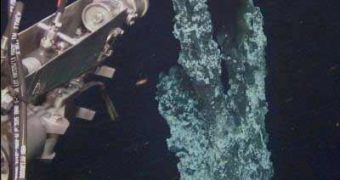A black smoker hydrothermal vent, measuring some 12 meters in height and ejecting water reaching temperatures of more than 200 degrees Celsius into the icy oceanic waters inside the Arctic Circle, was found by researchers more than 192 kilometers north of other known vents, making it the farther north such geological structure discovered to date. It is in fact a cluster of five hydrothermal vents located between Greenland and Norway, in a region of the ocean floor known as the Mid-Atlantic Ridge.
Similar vents have been previously found throughout the years in different regions of the world deep beneath the surface of the ocean, and although no sunlight penetrates the floor, these structures were proven on more than one occasion to be able to support living beings by providing both heat and the nutrients to feed them. Some researchers go as far as claiming that these locations could have been the place where life originated, which is often reflected in polemics regarding life on other planets and natural satellites.
Minerals dissolved in the boiling waters solidify when coming in contact with the chilly waters of the ocean floor, forming chimney-like solid structures or massive mineral deposits on the seafloor. Hydrothermal vents usually appear along the ridges separating two or more tectonic plates, and as water seeps deep into the cracks of the floor, it is heated and then convected up again.
"We hadn't expected a lot of active venting on ultra-slow spreading ridges," said oceanographer Marvin Lilley of the University of Washington, part of the expedition detailing the new findings.
The high content of minerals inside the hot water exiting the vent renders the surrounding areas mostly black; these ares are then covered by white bacteria populations living in the vicinity of the opening. The redder chimneys are usually the oldest, due to the oxidation of iron in the mineral. Observations indicate that the whole deposit is some 90 meters across at the top, while the base measures about 250 meters in diameter.
"Given the massive sulfide deposit, the vent field must surely have been active for many thousands of years," Lilley said.
Other observations made with the help of remotely operated vehicles suggest that the region is a unique ecosystem populated both by microorganisms and animals, as opposed to other communities living around hydrothermal vents found elsewhere. The expedition was led by Rolf Pedersen of the University of Bergen, Norway.

 14 DAY TRIAL //
14 DAY TRIAL //